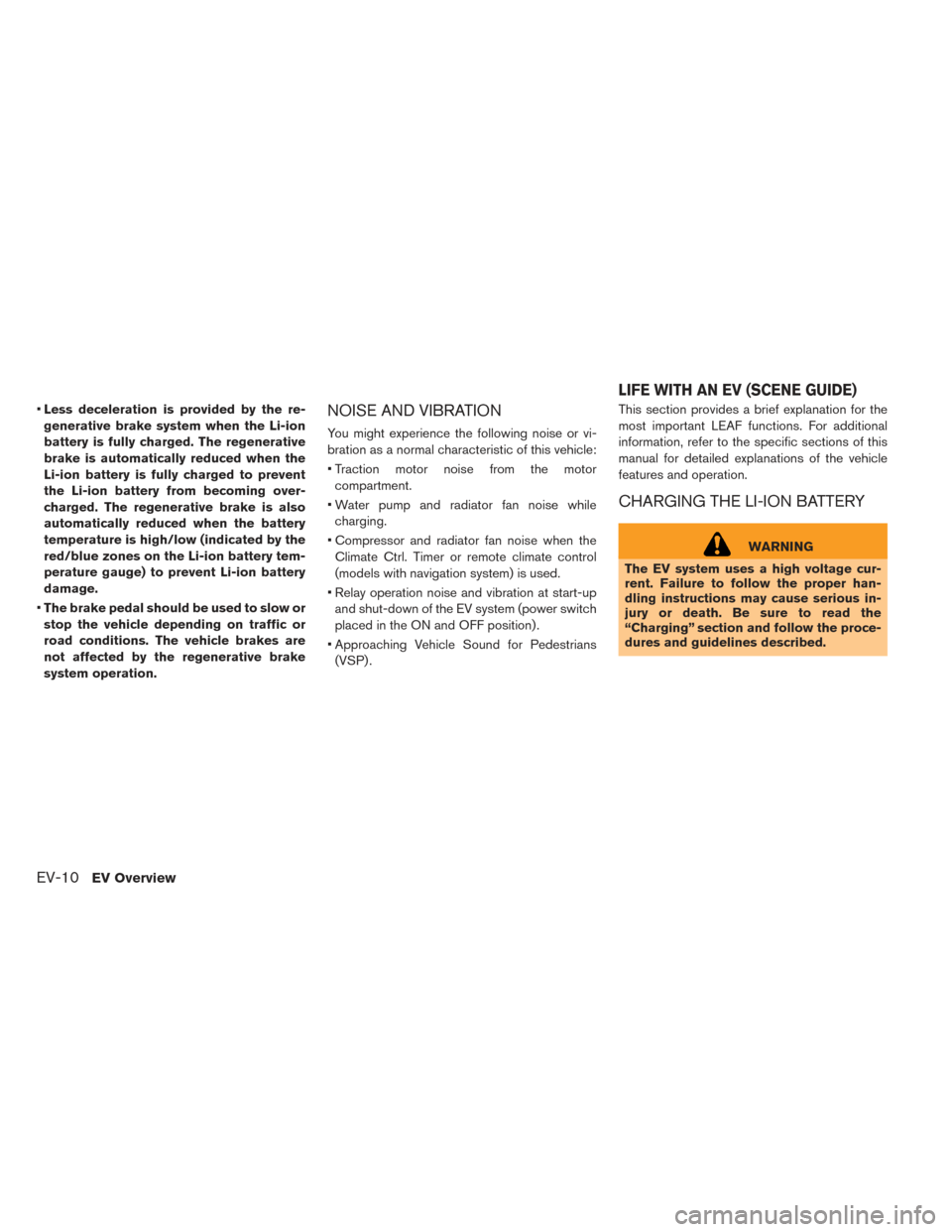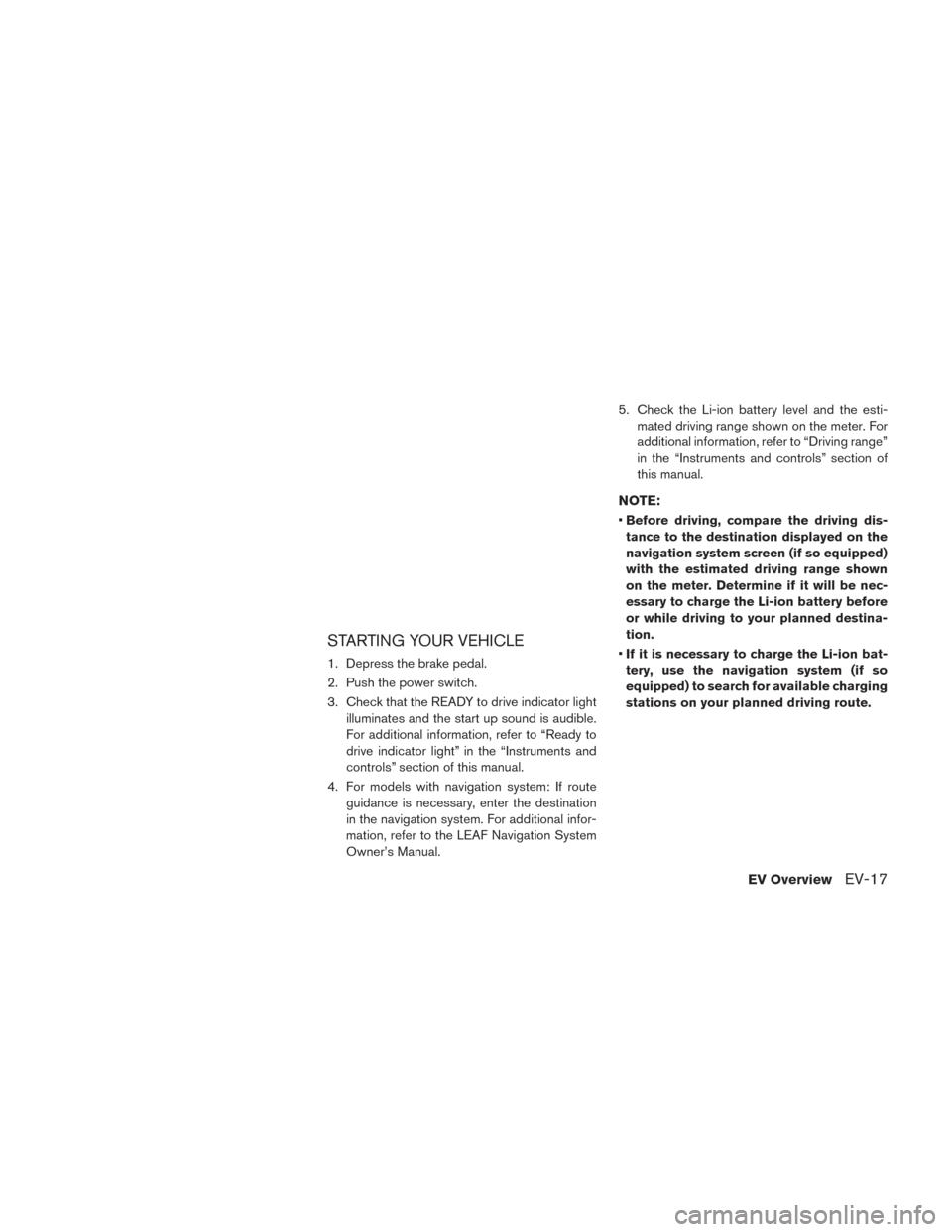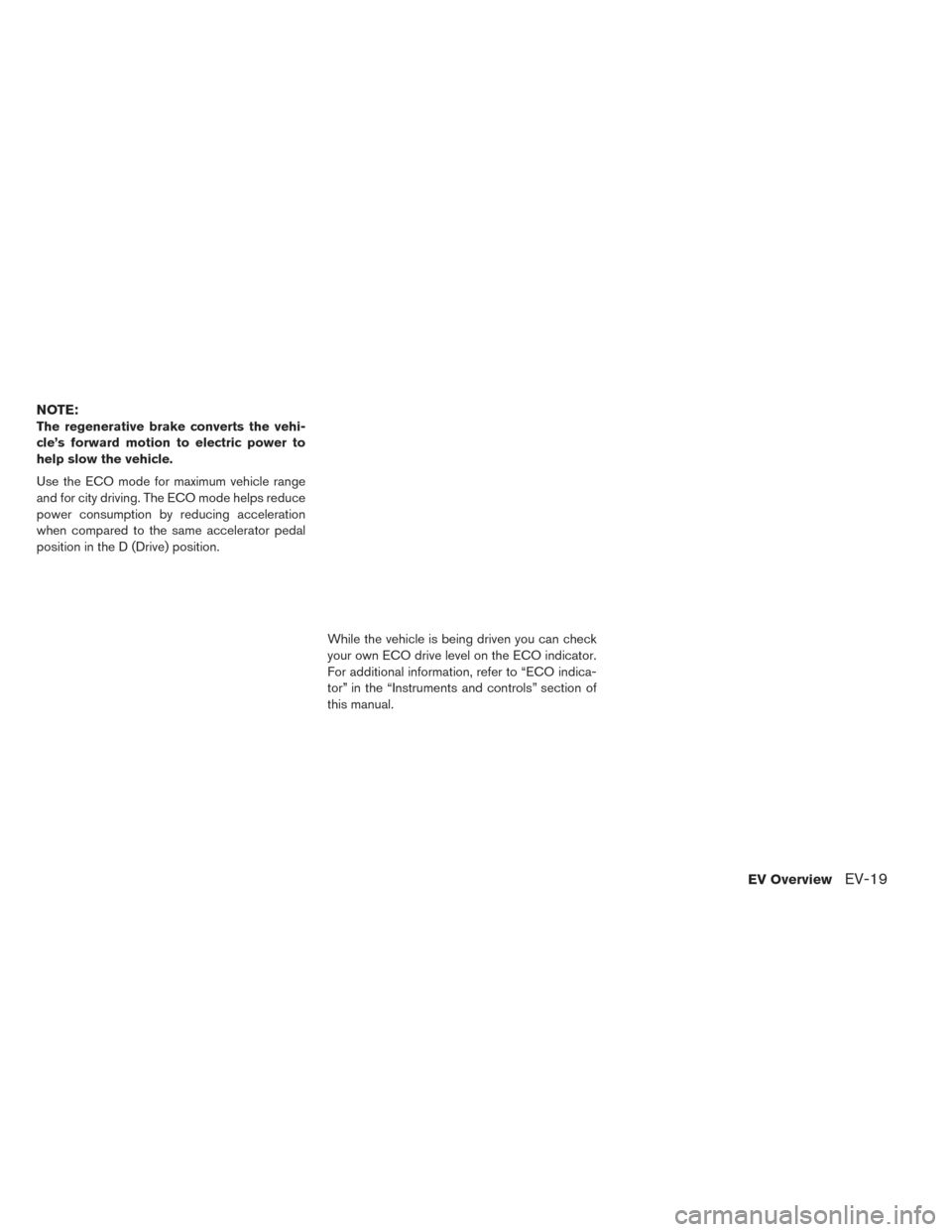2017 NISSAN LEAF brake
[x] Cancel search: brakePage 17 of 424

1. Brake fluid reservoir (P. 8-10)
2. 12-volt battery (P. 8-12)
3. Fuse holder (P. 8-17)
4. Fuse/Fusible link holder (P. 8-17)
5. Coolant reservoir cap (P. 8-8)
6. Windshield-washer fluid reservoir (P. 8-11)
7. Fuse/Fusible link holder (P. 8-17)
MOTOR COMPARTMENT
0-10Illustrated table of contents
Page 18 of 424

Warn-ing
light Name
Page
12-volt battery charge
warning light 2-13
Anti-lock Braking Sys-
tem (ABS) warning light2-14
Approaching Vehicle
Sound for Pedestrians
(VSP) system warning
light2-14
BRAKE system warning
light (yellow)
2-15
BRAKE warning light
(red)2-15
Electric shift control sys-
tem warning light2-16
Warn-
ing
light Name
Page
Electric Vehicle (EV)
system warning light 2-16
Headlight warning light 2-16
Low battery charge
warning light2-16
Low tire pressure warn-
ing light2-17
Master warning light
(red/yellow)2-18
Power steering warning
light2-18
Seat belt warning light 2-19
Warn-
ing
light Name
Page
Supplemental air bag
warning light 2-19
Indica-
tor
light Name
Page
ECO mode switch indi-
cator light 2-20
Exterior light indicator
light2-20
Front fog light indicator
light (if so equipped)2-20
Front passenger air bag
status light2-20
High beam indicator
light (blue)2-20
WARNING AND INDICATOR LIGHTS
Illustrated table of contents0-11
Page 27 of 424

WARNING
In case of a collision:
• If your vehicle is drivable, pull your vehicle off the road, push the P (Park)
position switch on the shift lever, apply
the parking brake and turn the EV sys-
tem off.
• Check your vehicle to see if there are exposed high-voltage parts or cables.
For their locations, refer to “High volt-
age components” in this section. To
avoid personal injury, never touch
high-voltage wiring, connectors, and
other high-voltage parts, such as in-
verter unit and Li-ion battery. An elec-
tric shock may occur if exposed electric
wires are visible when viewed from
inside or outside of your vehicle.
Therefore, never touch exposed elec-
tric wires.
• If the vehicle receives a strong impact to the floor while driving, stop the ve-
hicle in a safe location and check the
floor. • Leaks or damage to the Li-ion battery
may result in a fire. If you discover
them, contact emergency services im-
mediately. Since the fluid leak may be
lithium manganate from the Li-ion bat-
tery, never touch the fluid leak inside
or outside the vehicle. If the fluid con-
tacts your skin or eyes, wash it off
immediately with a large amount of
water and receive immediate medical
attention to help avoid serious injury.
• If a fire occurs in the EV, leave the vehicle as soon as possible. Only use a
type ABC, BC or C fire extinguisher
that is meant for use on electrical fires.
Using a small amount of water or the
incorrect fire extinguisher can result in
serious injury or death from electrical
shock.
• If your vehicle needs to be towed, do it with the front wheels raised. If the
front wheels are on the ground when
towing, the traction motor may gener-
ate electricity. This may damage the
components of the EV system and
cause a fire. • If you are not able to safely assess the
vehicle due to vehicle damage, do not
touch the vehicle. Leave the vehicle
and contact emergency services. Ad-
vise first responders that this is an
electric vehicle.
• In the event of an accident that re- quires body repair and painting, the
Li-ion battery pack and high voltage
parts such as the inverter, including
the wire harness, should be removed
prior to painting. It is recommended
that you visit a NISSAN certified LEAF
dealer for this service. Li-ion battery
packs exposed to heat in the paint
booth will experience capacity loss.
Damaged Li-ion battery packs may
also pose safety risks to untrained me-
chanics and repair personnel.
ROAD ACCIDENT PRECAUTIONS
EV-8EV Overview
Page 28 of 424

EMERGENCY SHUT-OFF SYSTEM
The emergency shut-off system is activated and
the high-voltage system automatically turns off in
the following conditions:
- Front and side collisions in which the air bags
are deployed.
- Certain rear collisions.
- Certain EV system malfunctions.
For the above collisions and certain other EV
system malfunctions, the READY to drive indica-
tor light will turn off. For additional information,
refer to “Warning lights, indicator lights and au-
dible reminders” in the “Instruments and con-
trols” section of this manual.
The emergency shut-off activates for the above
collisions to minimize risk of an event that could
cause injury or an accident. If the emergency
shut-off system activates, the EV system may not
be switched to the READY to drive position; it is
recommended that you visit a NISSAN certified
LEAF dealer. Even if the power switch is
switched to the READY to drive position, the
system may shut-off suddenly. Therefore, drive
cautiously to the nearest certified repair facility; it
is recommended that you visit a NISSAN certified
LEAF dealer for service.WARNING
• Pay special attention to pedestrians. Because there is no engine noise, pe-
destrians may not know the vehicle is
approaching, moving or about to
move, and may step into the path of
vehicle travel.
• When leaving the vehicle, be sure to turn off the EV system.
• Be sure to push the P (Park) position switch on the shift lever and apply the
parking brake when parking because
the vehicle can move when the READY
to drive indicator light is ON. When the
READY to drive indicator light is ON,
do not leave your vehicle in a shift
position other than the P (Park) posi-
tion.
• Keep the brake pedal depressed until you are ready to drive. When the ve-
hicle is in the D (Drive) position, B or R
(Reverse) position, if you release the
brake pedal and do not depress the
accelerator, the vehicle will creep and
may start abruptly. This may cause se-
rious injury or death.
NOTE:
•The vehicle cannot run with a discharged
Li-ion battery. Repeated acceleration con-
sumes more power from the Li-ion battery
than driving at a steady speed.
• This vehicle is equipped with a regenera-
tive brake system. The primary purpose of
the regenerative brake system is to pro-
vide some power to recharge the Li-ion
battery and extend driving range. A sec-
ondary benefit is “engine braking” that
operates based on Li-ion battery condi-
tions.
• In the D (Drive) position, when the accel-
erator pedal is released, the regenerative
brake system provides some decelera-
tion.
• When you put the shift lever in the B
position and take your foot off the accel-
erator pedal, more regenerative brake is
applied than in the D (Drive) position.
EV CHARACTERISTICS
EV OverviewEV-9
Page 29 of 424

•Less deceleration is provided by the re-
generative brake system when the Li-ion
battery is fully charged. The regenerative
brake is automatically reduced when the
Li-ion battery is fully charged to prevent
the Li-ion battery from becoming over-
charged. The regenerative brake is also
automatically reduced when the battery
temperature is high/low (indicated by the
red/blue zones on the Li-ion battery tem-
perature gauge) to prevent Li-ion battery
damage.
• The brake pedal should be used to slow or
stop the vehicle depending on traffic or
road conditions. The vehicle brakes are
not affected by the regenerative brake
system operation.NOISE AND VIBRATION
You might experience the following noise or vi-
bration as a normal characteristic of this vehicle:
• Traction motor noise from the motor compartment.
• Water pump and radiator fan noise while charging.
• Compressor and radiator fan noise when the Climate Ctrl. Timer or remote climate control
(models with navigation system) is used.
• Relay operation noise and vibration at start-up and shut-down of the EV system (power switch
placed in the ON and OFF position) .
• Approaching Vehicle Sound for Pedestrians (VSP) . This section provides a brief explanation for the
most important LEAF functions. For additional
information, refer to the specific sections of this
manual for detailed explanations of the vehicle
features and operation.
CHARGING THE LI-ION BATTERY
WARNING
The EV system uses a high voltage cur-
rent. Failure to follow the proper han-
dling instructions may cause serious in-
jury or death. Be sure to read the
“Charging” section and follow the proce-
dures and guidelines described.
LIFE WITH AN EV (SCENE GUIDE)
EV-10EV Overview
Page 36 of 424

STARTING YOUR VEHICLE
1. Depress the brake pedal.
2. Push the power switch.
3. Check that the READY to drive indicator lightilluminates and the start up sound is audible.
For additional information, refer to “Ready to
drive indicator light” in the “Instruments and
controls” section of this manual.
4. For models with navigation system: If route guidance is necessary, enter the destination
in the navigation system. For additional infor-
mation, refer to the LEAF Navigation System
Owner’s Manual. 5. Check the Li-ion battery level and the esti-
mated driving range shown on the meter. For
additional information, refer to “Driving range”
in the “Instruments and controls” section of
this manual.
NOTE:
•Before driving, compare the driving dis-
tance to the destination displayed on the
navigation system screen (if so equipped)
with the estimated driving range shown
on the meter. Determine if it will be nec-
essary to charge the Li-ion battery before
or while driving to your planned destina-
tion.
• If it is necessary to charge the Li-ion bat-
tery, use the navigation system (if so
equipped) to search for available charging
stations on your planned driving route.
EV OverviewEV-17
Page 37 of 424

DRIVING THE VEHICLE
1. Depress the brake pedal.
2. Release the parking brake.
3. Move the shift lever into the D (Drive) position.When released, the shift lever returns to its
original center position.
4. Confirm that the vehicle is in the D (Drive) position. The indicator next to the “D” by the
shift lever illuminates and “D” is displayed on
the meter. 5. Release the brake pedal.
6. Depress the accelerator pedal and start
driving. These are the following gear positions for driving
the vehicle forward:
• Use the D (Drive) position for optimum driving
performance.
• Use the B position for downhill driving. When the B position is used, more regenerative brake
is applied when the accelerator pedal is re-
leased in comparison to the D (Drive) position.
For additional information, refer to “Driving the
vehicle” in the “Starting and driving” section of
this manual.
EV-18EV Overview
Page 38 of 424

NOTE:
The regenerative brake converts the vehi-
cle’s forward motion to electric power to
help slow the vehicle.
Use the ECO mode for maximum vehicle range
and for city driving. The ECO mode helps reduce
power consumption by reducing acceleration
when compared to the same accelerator pedal
position in the D (Drive) position.While the vehicle is being driven you can check
your own ECO drive level on the ECO indicator.
For additional information, refer to “ECO indica-
tor” in the “Instruments and controls” section of
this manual.
EV OverviewEV-19